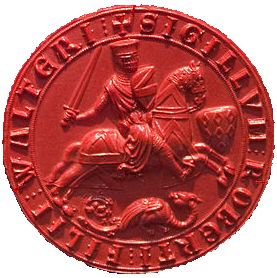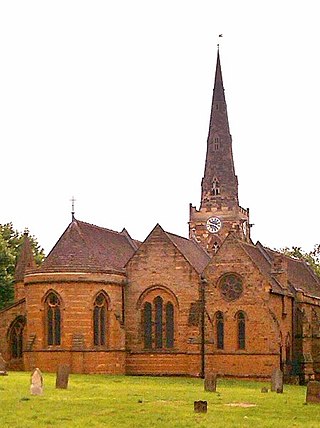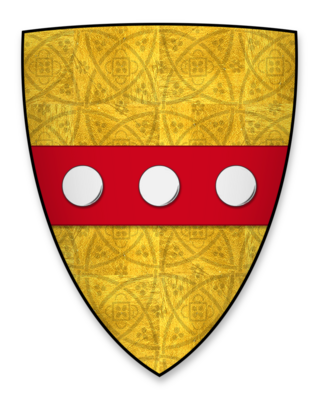
Henry de Bohun, 1st Earl of Hereford of Pleshy Castle in Essex, was an Anglo-Norman nobleman who became Hereditary Constable of England from 1199.

Earl of Huntingdon is a title which has been created several times in the Peerage of England. The medieval title was associated with the ruling house of Scotland.

Earl of Northampton is a title in the Peerage of England that has been created five times.

Saer de Quincy, 1st Earl of Winchester was one of the leaders of the baronial rebellion against John, King of England, and a major figure in both the kingdoms of Scotland and England in the decades around the turn of the twelfth and thirteenth centuries.
Maud, Countess of Huntingdon, or Matilda, was Queen of Scotland as the wife of King David I. She was the great-niece of William the Conqueror and the granddaughter of Earl Siward.
Waltheof was a 12th-century English abbot and saint. He was the son of Simon I of St Liz, 1st Earl of Northampton and Maud, 2nd Countess of Huntingdon, thus stepson to David I of Scotland, and the grandson of Waltheof, Earl of Northampton.
Robert Fitz Richard (1064–1136) was an Anglo-Norman feudal baron of Little Dunmow, Essex and constable of Baynard's Castle in the City of London. His feudal barony, the caput of which was at Little Dunmow in Essex, was granted to him by the king after it had been forfeited in 1110 by William Baynard, whose grandfather Ralph Baynard was the first holder and the builder of Baynard's Castle in the City of London.

Robert Fitzwalter was one of the leaders of the baronial opposition against King John, and one of the twenty-five sureties of Magna Carta. He was feudal baron of Little Dunmow, Essex and constable of Baynard's Castle, in London, to which was annexed the hereditary office of castellan and chief knight banneret of the City of London. Part of the official aristocracy created by Henry I and Henry II, he served John in the wars in Normandy, in which he was taken prisoner by King Philip II of France and forced to pay a heavy ransom.

The Holy Sepulchre is a Norman round church in Sheep Street, Northampton, England. It is a Grade I listed building. Dating from circa 1100, it was possibly built by Simon de Senlis, Earl of Northampton.
Simon II de Senlis, 4th Earl of the Honour of Huntingdon and Northampton was an Anglo-Norman nobleman. He was the son of Simon I de Senlis, Earl of Huntingdon-Northampton and Maud, Countess of Huntingdon. He married Isabel, daughter of Robert de Beaumont, 2nd Earl of Leicester and they had a son Simon.

William of Huntingfield was a medieval English baron, Sheriff of Norfolk and Suffolk and one of the Magna Carta sureties.
Events from the 1210s in England.
Hawise of Chester, 1st Countess of Lincoln suo jure, was an Anglo-Norman noblewoman and a wealthy heiress. Her father was Hugh de Kevelioc, 5th Earl of Chester. She was the sister and a co-heiress of Ranulf de Blondeville, 6th Earl of Chester. She was created suo jure 1st Countess of Lincoln in 1232. She was the wife of Robert de Quincy, by whom she had one daughter, Margaret, who became heiress to her title and estates. She was also known as Hawise of Kevelioc.

Piddington is a village and civil parish about 4.5 miles (7 km) southeast of Bicester in Oxfordshire, England. It lies close to the border with Buckinghamshire. Its toponym has been attributed to the Old English Pyda's tun. The 2011 Census recorded the parish's population as 370.

John de Lacy, 2nd Earl of Lincoln was hereditary Constable of Chester, 7th Baron of Pontefract, 8th Baron of Halton and 8th Lord of Bowland.

Fotheringhay Castle, also known as Fotheringay Castle, was a High Middle Age Norman Motte-and-bailey castle in the village of Fotheringhay 3+1⁄2 miles (5.6 km) to the north of the market town of Oundle, Northamptonshire, England. It was probably founded around 1100 by Simon de Senlis, Earl of Northampton. In 1113, possession passed to Prince David of Scotland when he married Simon's widow. The castle then descended with the Scottish princes until the early 13th century, when it was confiscated by King John of England.
St Andrew's Priory was a Cluniac house in Northampton, England.
Sir Robert de Quincy, Justiciar of Lothian, was a 12th-century English and Scottish noble.
Simon III de Senlis, Earl of Huntingdon and Northampton was an English nobleman.